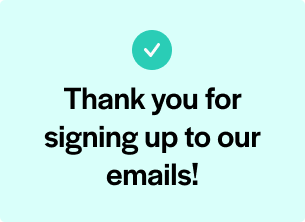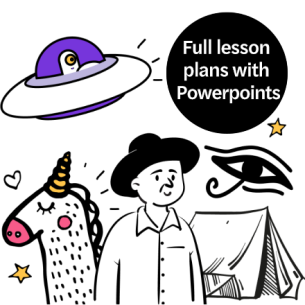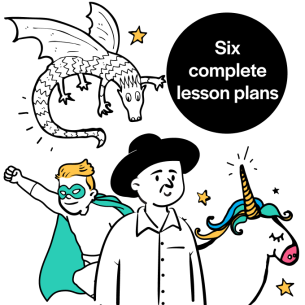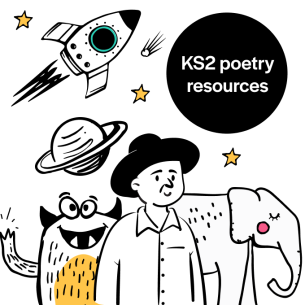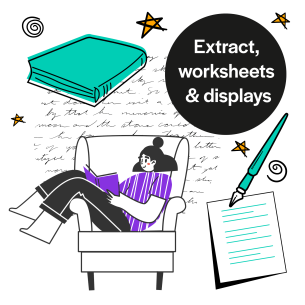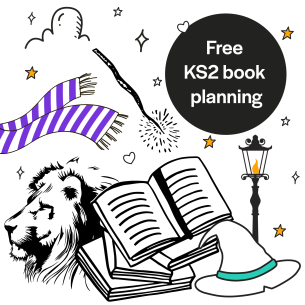These sheets have been created by Michael Tidd to support teachers to teach a variety of history units and include history timeline KS2 information as well as lots more useful content.
History units included:
- Pre-history
- Roman Britain
- Anglo-Saxons & Scots
- Anglo-Saxons & Vikings
- Ancient Greece
- Ancient Sumer
- Indus Valley
- Ancient Egypt
- Shang Dynasty of Ancient China
- Early Islamic Civilization
- Mayans KS2
- Benin, West Africa
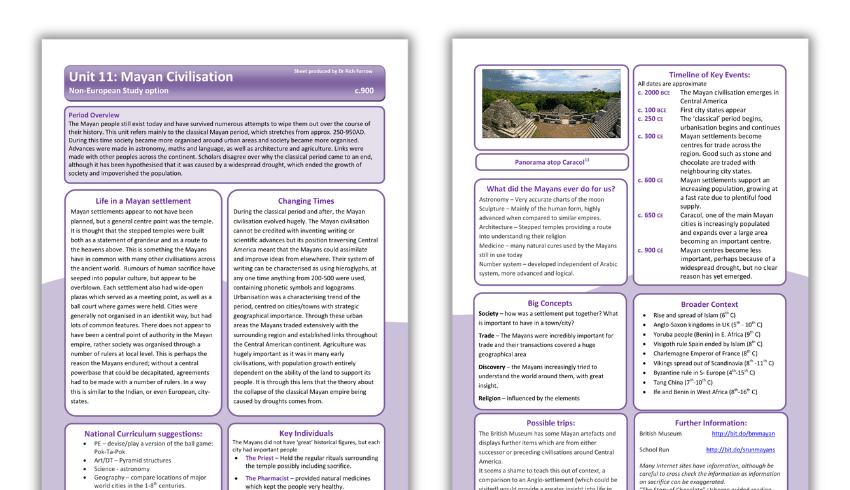
The factsheets for each unit contain:
- Period overview
- Possible enquiry questions
- Key individuals
- Inventions
- History timeline KS2
- Big concepts
- Themes
- Broader context
- Places to visit
- Links to further information
Created by experts
History experts have shared their knowledge to create many of the topic sheets inside this download, including:
- Kim Biddulph of SchoolsPreHistory.co.uk (units 1 and 9)
- Tim Taylor of imaginative-inquiry.co.uk (unit 2)
- Jo Pearson of Teamworks TSA (unit 5)
- Ilona Aronovsky, archaeologist (unit 7)
- Rich Farrow of St Marks School, Stockport (units 10 and 11)
- Alison Leach (unit 12)
All of the authors have kindly agreed to share their work under a Creative Commons Licence to allow schools to make use of the materials freely. If you want to adapt the material, please ensure you comply with the licence by acknowledging the original authors.
Construct a hands-on history timeline using multi-link cubes
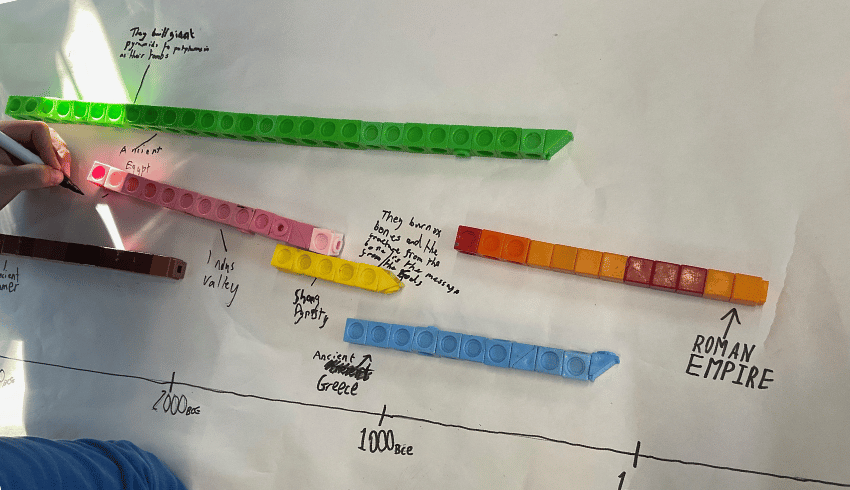
Teacher Karl McGrath explains how constructing a visual, hands-on history timeline using multi-link cubes can help KS2 children develop a better understanding of chronology and overlap between early civilisations…
In Year 6, we’ve been exploring early civilisations. It was clear the children didn’t have a strong sense of chronology. I wanted them to understand how civilisations coexisted and weren’t all completely isolated from one another.
To achieve this, my KS2 pupils constructed history timelines using multi-link cubes, with each civilisation represented by a different colour.
This activity is inspired by the work of Stuart Tiffany, who is a self-professed chronology geek. This is the second time I’ve used it. I’ve found it really helps the children visualise historical scale and overlap.
History timelines
Start by discussing the word chronology and what it means. Talk about how you might have already used conventional history timelines in KS1 and KS2, and why they’re useful.
To make this concept concrete, introduce multi-link cubes as physical representations of time. We decided that each block equalled 100 years, but you can divide them up however works best for your unit.
Each civilisation is also assigned a specific colour. Before starting, explore historical misconceptions, including that civilisations appear one after another in a rigid sequence.
Start construction
Now you can start constructing your multi-link timeline. Use a long roll of paper, as well as a selection of different coloured multi-link cubes. Add civilisations one at at a time so you can talk through them.
As the children build their timelines, encourage them to work together, making observations and questioning overlaps. You can stop periodically to encourage critical thinking.
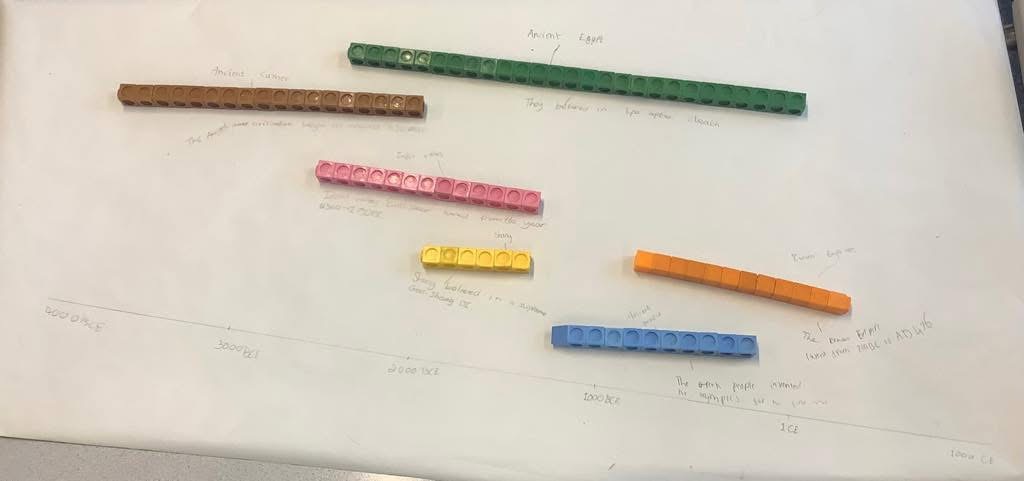
Once you have constructed your history timelines, you can reflect on the patterns your KS2 pupils have noticed, and talk about any misconceptions they might have. For example:
- a civilisation doesn’t necessarily have to end before another can begin
- overlap doesn’t have to mean that civilisations rose or fell
- some civilisations existed independently
- although the cubes are useful tools to help visualise trends, the models aren’t exactly to scale
Proportional scaling
While the cubes are a useful representation, it’s important to emphasise proportional differences between time periods.
For example, the Ancient Egyptian civilisation lasted over 3,000 years, significantly longer than many others. Try and use proportional scaling where possible to improve pupils’ accuracy.
You can link this activity to wider learning by discussing things like trade and technological exchange between civilisations that overlapped.
This can come in handy for future lessons, as I found that children improved in confidence in using timelines as an analytical tool, rather than just as a reference point.
This approach can spark some fantastic discussions, particularly around the complexity of history and how civilisations interact.
I also recommend that each year group does this, to embed true chronological understanding at each stage of their learning.
Karl McGrath is a Year 6 teacher and curriculum task design lead at Benton Park Primary. Follow him on X at @MRMICT. Download a printable British history timeline classroom display.
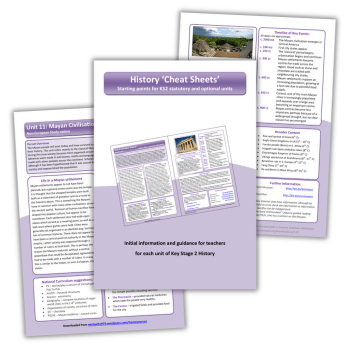
Similar resources
- Stone Age to Iron Age – KS2 medium-term plan with resources
- Cobweb by Michael Morpurgo – Cross-curricular activities for KS2
- Arctic explorers – KS2 creative writing and geography resource
- Viking worksheets – Colour-and-write sheets for history & writing
- Geological timeline – Cut-out and colour-in spiral activity


